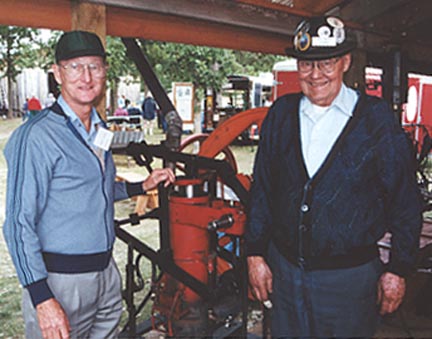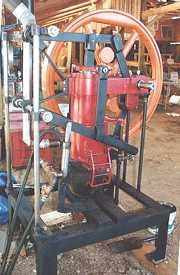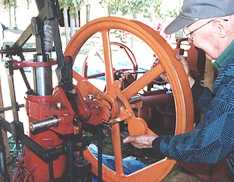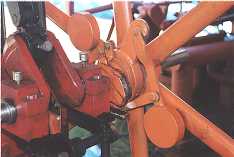The Trewhella
Engine Recovered!
New
10/24/2000
At Lake Itasca, as mentioned in the main text of
that report, we met Rob and Bev Isdale. Rob finds and restores full sized
Stirling engines (maybe he will grace us with some stories of those adventures
at a later date!) and in our conversations, he told me the following story.
It is one of those serendipitous happenings, but as some wise man once said,
"Chance favors the prepared mind." I think you will agree that this is
a story well worth telling, so without further ado, we present...
IT’S
TRUE. THE RUMOR IS TRUE !
THERE
IS A TREWHELLA HOT AIR ENGINE
by Robert Isdale © 2000
Anyone who is interested in hot-air engines in
Australia eventually gets to hear the rumour that the Trewhella Engineering
business in Victoria, produced a hot air engine at some time.
I have never heard of anyone actually seeing one – or even parts
thereof, so it was always just that – a rumour.
The Trewhella business produced a wide range of
well designed and well made products, and their tree pulling winches played an
enormous role in the land clearing sagas of the early pioneering days. It was
very respectable gear indeed, most worthy of being displayed in a restored
machinery Rally, which is exactly what Ray Knight was doing at the Australian
National Rally at Henty in 1999. He
had a large range of very well presented Trewhella equipment, and Beverley and I
stopped at the fence to admire this good example of Australia’s engineering
heritage.
We chatted with Ray and I asked him if he had heard
the rumour about Trewhella having made a hot-air engine. He said he had heard the rumour, but had no knowledge of an
actual engine. However as we spoke,
he thought of a person who had some knowledge of the history of the business,
and said that he would ask him specifically if there was any truth to the rumour.
I gave Ray my phone number and said that I would be pleased to hear the
result of his enquiry. The Henty
Rally covered a huge area, so we did not get back to Ray’s area during our
visit.
About a month later, at home in Brisbane, I was a
bit surprised to have a phone call from a bloke I had never heard of, who asked
if I was the person asking about Trewhella hot-air engines at the Henty Rally. I
cautiously said that I was, and he said that his name was Steve Shannon, and
that he is related to the Trewhella family.
He told me that the present members of the family
had no knowledge as to whether the original William Trewhella had made any
hot-air engines in the early days of the business – the late 1800’s.
He went on to say that when he was at the Henty Rally, and saw Ray
Knight’s display of winches, he asked him if he knew anything of the rumour
about the hot-air engine. Ray, suitably surprised, told him that less than 10
minutes ago a bloke from Queensland who restores hot-air engines had asked him
exactly the same question. Steve got my phone number from Ray, and spent the rest of the
day trying to find me.
I was pleased to speak to Steve about Trewhella
history, and this rumour, and then
he said that although they have no knowledge of an actual engine, he had some of
the old records relating to the business in a safe in the next room, and amongst
them is a patent awarded to William Trewhella, for a hot-air engine.
It was a rare moment indeed, and I might even have
been stuck for words for a moment or three. I asked if it would be possible to
see the patent, and Steve said that he had hoped that I would be interested,
because he would be pleased to have my opinion as to whether I thought an
operating engine could be produced from those patent specifications and
diagrams.
I said that I would be pleased to assess the
material, and I added that a person who I would like to also look at the patent
is a chap in Minnesota USA, Olaf Berge. I explained that Olaf has reconstructed
a couple of hot-air engines from patent drawings, where no examples are known to
exist now. Steve agreed that it would be good to have Olaf’s opinion also.
Patent number 11357, is dated 19th. May
1894 in the state of Victoria, Australia, and also registered in New South
Wales, South Australia, Queensland and West Australia.
It is also registered as number 550,603, dated 17th August
1897, at the United States Patent Office. A Canadian patent (perhaps dated 1897)
is mentioned, but the patent number is not known.
The style of the engine is to have a gradual and
continuous feed of fine coal dropping on to a continuous internal fire, and the
air is made to move through the fire grate itself, and exit via a valve system.
The patent plans were like all patents in that the
idea was conveyed to the patent examiner, without giving too much information to
a competitor. Industrial intrigue
has always been alive and well. I
felt certain that with some changes to the size of air flow valves and passages,
and also to the automatic coal feed system, that it would function like any
other furnace gas induction hot-air engine. The Buckett engine and the Roper are
not all that different in their operating principle. I discussed this with Steve
and Olaf replied with the same opinion.
William Trewhella might well have made such changes
as he produced a practical prototype engine from the schematic representations
in the patent illustrations. We
will never know, but we can be reasonably certain that there was never a
commercial production of such an engine.
The second National Meet of Hot –Air exhibitors
was to be held at Lake Itasca in Minnesota from the 18th to 20th
August 2000. The only other such
meet had been nine years before, and since then, there has been a lot of
activity in the recovery and restoration of these engines, and in Stirling
engine development generally. If ever there was a good time to visit the USA,
this event seemed like a good central point to organise around.
Beverley and I made our plans and arranged to meet
in Fargo, with another enthusiast and his wife, Bob Sier and Lisl, from England.
We would then drive on to Lake Itasca, where Olaf was the Rally organiser
for the event. People came from all
around the USA, some driving about 1200 miles – about three or four days,
pulling trailers loaded with precious exhibits. Another enthusiasts came from
Mexico and Canada.
We all arrived at the Rally grounds and we finally
met Olaf Berge, and his wife Waltraut (known affectionately to everyone as
Wally). Having known of the man and
admired his work for so long, it was a special moment indeed.
As we looked around the Hot Air Engine Shed being
prepared for the show, and seeing “in the flesh” his remarkable re-created
engines, he pulled the cover off another one, and asked, “Robert, have you
seen one of these?”  I would have to say that, at that point, my brain was performing like one
of those pin-ball machines with a ricocheting ball and flashing lights in all
directions. No, I had not seen that
shape of engine / yes, the mechanism looked somehow familiar / no, I had not
seen this style of internal firing layout / yes, I felt that I knew something
about this governor cam mechanism -
-. “Olaf,” I asked, “ what
engine is this one?” “It’s a
Trewhella. When I knew that you were coming to Lake Itasca, I made it for you as
a surprise.” And that was when
Olaf’s wife Wally took the photograph. I
have not seen the print yet, but the expression on my face must say it all.
(Editor's note: that's Rob on the left with the stunned expression!)
I would have to say that, at that point, my brain was performing like one
of those pin-ball machines with a ricocheting ball and flashing lights in all
directions. No, I had not seen that
shape of engine / yes, the mechanism looked somehow familiar / no, I had not
seen this style of internal firing layout / yes, I felt that I knew something
about this governor cam mechanism -
-. “Olaf,” I asked, “ what
engine is this one?” “It’s a
Trewhella. When I knew that you were coming to Lake Itasca, I made it for you as
a surprise.” And that was when
Olaf’s wife Wally took the photograph. I
have not seen the print yet, but the expression on my face must say it all.
(Editor's note: that's Rob on the left with the stunned expression!)
As far as we know, it was the World Premiere for
this 1894 Trewhella hot air engine. Coal
fired internal combustion, an ingenious cam mechanism, and it ran like a Swiss
watch for the duration of the Rally. For me, that was the highlight of the Lake
Itasca visit. Thank you Olaf.
© Robert
Isdale, Brisbane, Australia, October, 2000
Update
mid 2002
Amazing!
Rob was contacted by a descendant of the inventor of this engine. See his follow
up report here.
Below are some more photos of the cam mechanism and the
engine. As usual, just click on the photo for a larger view.
|

|
 |
 |
|
Overall view of the engine |
The cam mechanism (open) |
The cam mechanism (closed) |
 I would have to say that, at that point, my brain was performing like one
of those pin-ball machines with a ricocheting ball and flashing lights in all
directions. No, I had not seen that
shape of engine / yes, the mechanism looked somehow familiar / no, I had not
seen this style of internal firing layout / yes, I felt that I knew something
about this governor cam mechanism -
-. “Olaf,” I asked, “ what
engine is this one?” “It’s a
Trewhella. When I knew that you were coming to Lake Itasca, I made it for you as
a surprise.” And that was when
Olaf’s wife Wally took the photograph. I
have not seen the print yet, but the expression on my face must say it all.
(Editor's note: that's Rob on the left with the stunned expression!)
I would have to say that, at that point, my brain was performing like one
of those pin-ball machines with a ricocheting ball and flashing lights in all
directions. No, I had not seen that
shape of engine / yes, the mechanism looked somehow familiar / no, I had not
seen this style of internal firing layout / yes, I felt that I knew something
about this governor cam mechanism -
-. “Olaf,” I asked, “ what
engine is this one?” “It’s a
Trewhella. When I knew that you were coming to Lake Itasca, I made it for you as
a surprise.” And that was when
Olaf’s wife Wally took the photograph. I
have not seen the print yet, but the expression on my face must say it all.
(Editor's note: that's Rob on the left with the stunned expression!) 

